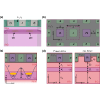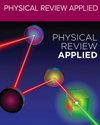Mitigating variability in epitaxial-heterostructure-based spin-qubit devices by optimizing gate layout
IF 4.4
2区 物理与天体物理
Q2 PHYSICS, APPLIED
引用次数: 0
Abstract
The scalability of spin-qubit devices is conditioned by qubit-to-qubit variability. Disorder in the host materials indeed affects the wave functions of the confined carriers, which leads to variations in their charge and spin properties. Charge disorder in the amorphous oxides is particularly detrimental owing to its long-range influence. Here we analyze the effects of charge traps at the semiconductor-oxide interface, which are generally believed to play a dominant role in variability. We consider multiple random distributions of these interface traps and numerically calculate their impact on the chemical potentials, detuning, and tunnel coupling of two adjacent quantum dots in heterostructure. Our results highlight the beneficial screening effect of the metal gates. The surface of the heterostructure shall, therefore, be covered as much as possible by the gates in order to limit variability. We propose an alternative layout with tip-shaped gates that maximizes the coverage of the semiconductor-oxide interface and outperforms the usual planar layout in some regimes. This highlights the importance of design in the management of device-to-device variability.

通过优化栅极布局降低基于外延-异质结构的自旋量子比特器件的变异性
自旋量子比特器件的可扩展性受制于量子比特与量子比特之间的变化。宿主材料中的无序确实会影响约束载流子的波函数,从而导致其电荷和自旋特性的变化。非晶氧化物中的电荷无序因其长程影响而尤其有害。在此,我们分析了半导体-氧化物界面电荷阱的影响,一般认为电荷阱在变化中起主导作用。我们考虑了这些界面陷阱的多种随机分布,并数值计算了它们对 SiGe 异质结构中相邻两个量子点的化学势、失谐和隧道耦合的影响。我们的结果凸显了金属栅极的有利屏蔽效应。因此,异质结构的表面应尽可能被栅极覆盖,以限制可变性。我们提出了一种具有尖端形状栅极的替代布局,它能最大限度地覆盖半导体-氧化物界面,并在某些情况下优于通常的平面布局。这凸显了设计在管理器件间变异性方面的重要性。
本文章由计算机程序翻译,如有差异,请以英文原文为准。
求助全文
约1分钟内获得全文
求助全文
来源期刊

Physical Review Applied
PHYSICS, APPLIED-
CiteScore
7.80
自引率
8.70%
发文量
760
审稿时长
2.5 months
期刊介绍:
Physical Review Applied (PRApplied) publishes high-quality papers that bridge the gap between engineering and physics, and between current and future technologies. PRApplied welcomes papers from both the engineering and physics communities, in academia and industry.
PRApplied focuses on topics including:
Biophysics, bioelectronics, and biomedical engineering,
Device physics,
Electronics,
Technology to harvest, store, and transmit energy, focusing on renewable energy technologies,
Geophysics and space science,
Industrial physics,
Magnetism and spintronics,
Metamaterials,
Microfluidics,
Nonlinear dynamics and pattern formation in natural or manufactured systems,
Nanoscience and nanotechnology,
Optics, optoelectronics, photonics, and photonic devices,
Quantum information processing, both algorithms and hardware,
Soft matter physics, including granular and complex fluids and active matter.
 求助内容:
求助内容: 应助结果提醒方式:
应助结果提醒方式:


